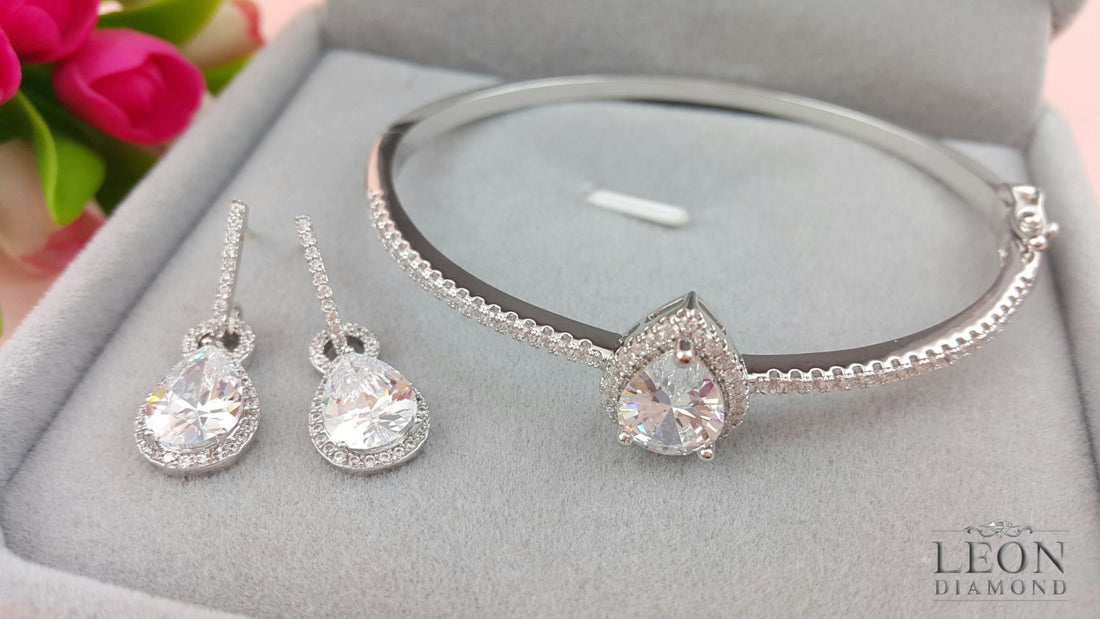
Common Mistakes People Make When Storing Diamond Jewelry
Share
A diamond's strength is unmatched, but its beauty is not immune to neglect. Even the most brilliant stone can lose its luster when stored carelessly. Scratches, metal tarnish, and loosened settings are often the result of common but avoidable storage habits.
Most people assume their jewelry is safe once it’s out of sight. Tucked in a box. Slipped into a drawer. But improper storage is one of the leading causes of long-term damage to fine jewelry, especially diamonds.
Read this article to see how 8 common storing mistakes can cause your diamond jewelry to lose its beauty and how you can avoid them!
8 Common Diamond Jewelry Storage Mistakes to Avoid

The following eight mistakes are among the most frequent culprits when diamonds lose their sparkle or suffer damage behind closed doors. Identify these pitfalls now so you can safeguard your investment and enjoy diamond jewelry for decades to come.
1. Storing Multiple Pieces Together
When rings, necklaces, and earrings share the same space, they rub against one another with the slightest movement. Over time, those tiny collisions create fine scratches on the diamond surface and wear away the prongs that hold stones in place. Also, chains can tangle into tight knots that put strain on links and clasps, which increases the risk of breakage.
To prevent this, dedicate a separate slot or pouch to each piece. Soft fabric dividers or individual velvet-lined trays keep items apart and cushion them against impact.
2. Using Loose Storage Compartments
A tray or box with wide, open sections might seem convenient, but loose storage allows pieces to slide and collide whenever you open or move the case. Even a brief shake can send rings and pendants clanging together. Metal settings rub against stone edges, and chains loop into tight tangles that require force to undo over time.
Choose organizers with molded slots or snug compartments designed for rings, earrings, and pendants. Foam inserts or plastic trays with individual wells hold each item securely in place. This simple change reduces friction and keeps your diamonds secure.
3. Using Unlined or Hard Containers
When the interior of your jewelry box is bare wood, metal, or hard plastic, every movement risks causing tiny surface abrasions. Even if a container looks smooth, its rigid walls offer no shock absorption. A dropped box or a simple shake can send your diamond rings or pendants rattling against unforgiving sides.
Invest in storage solutions that feature soft, cushioned linings such as velvet, suede, or microfiber. If you already have a rigid box you like, line its compartments with small fabric pouches or foam padding. That extra layer of protection prevents micro-scratches and keeps settings intact.
4. Skipping Anti-Tarnish Measures
Even though diamonds themselves do not tarnish, their metal settings can develop a dull, discolored film over time. Oxidation on silver and low-karat gold not only dulls the overall appearance but can trap dirt against the stone’s edge, making routine cleaning more difficult.
To keep metal bright, store your pieces with anti-tarnish strips or sachets. These small inserts absorb sulfur compounds that cause discoloration. You can also look for jewelry boxes lined with specially treated fabric designed to neutralize tarnish agents.
5. Exposure to Humidity and Heat
Too much moisture in the air can leave tiny water spots on your diamonds and cause metal settings to develop corrosion over time. Heat makes metal expand and contract, which can lead to loose prongs that secure your stones. When you store jewelry in a bathroom or near a heater, you expose it to this constant cycle of dampness and warmth.
Keep your collection in a cool, dry location away from windows and radiators. A bedroom closet or a dresser drawer works well. For extra protection, place a small sealed packet of silica gel beside your jewelry. That simple step controls moisture and helps maintain both shine and structural integrity.
6. Storing Near Chemical-Based Products
Chemicals in your home can also damage both the diamond’s setting and the metal around it. When you place jewelry near cleaners, perfumes, or cosmetics, vapors may settle on the surface and cause:
-
Metal Discoloration: Chlorine or bleach can corrode white gold and weaken solder joints.
-
Gemstone Film: Oils from lotions or hairspray leave a film that dulls sparkle and attracts dirt.
- Setting Damage: Acidic ingredients in nail polish remover or household cleaners can pit prongs and loosen stones.
Keep your Diamond jewelry box at a distance from the bathroom counter and kitchen shelves. Store pieces in a dedicated drawer or closet rack well away from cleaning supplies and beauty products. Before tucking them away, wipe each piece with a soft, dry cloth to remove any residue.
7. Improper Travel Storage
When you toss jewelry into a purse or suitcase without protection, you invite scratches, bent chains, and even lost stones. Turbulence or simple jostling can cause diamonds to knock against hard surfaces or each other. You also risk misplacing small pieces during unpacking or security checks.
Before you travel, invest in a compact jewelry case with padded slots for rings and hooks for necklaces. If space is tight, use individual soft pouches or a roll-style organizer where each item tucks into its own pocket.
8. Neglecting Regular Cleaning Before Storage
When you skip cleaning, everyday oils, lotions, or dust can build up on your diamond and its setting. This residue can trap moisture against the metal, which can cause prolonged weakening and accelerate tarnishing.
Before you put your jewelry away:
- Rinse each piece in a bowl of warm water mixed with a drop of mild dish soap
- Gently brush around the setting and under the diamond with a soft-bristled toothbrush
- Rinse again and pat completely dry with a lint-free cloth
By investing a few minutes, you can prevent trapped debris from accumulating and causing a long-term issue while your jewelry is in storage.
What to Do If The Damage’s Already Been Done?

Even with the best intentions, storage missteps can leave your diamond jewelry less than perfect.
If you spot scratches, loose stones, or dull metal, take these steps right away:
-
Inspect Every Piece
Lay your items on a soft cloth and look for hairline scratches on the diamond and any movement in the setting. Early detection prevents small issues from becoming major repairs.
-
Seek Professional Cleaning
A jeweler’s ultrasonic cleaner will remove embedded grime and restore brilliance. They can also polish minor surface scratches on metal settings.
-
Have Settings Repaired
If you find a loose prong or bent setting, do not wear the piece. Schedule a repair to tighten or replace prongs before a stone falls out.
-
Consider Replating
White gold settings may develop yellowish tints over time. Rhodium replating revives that bright, silvery finish and protects the metal underneath.
-
Review Your Insurance
If damage is extensive, you may qualify for repair or replacement under your jewelry insurance policy. Document the condition with photos and receipts before you send pieces in for service.
Taking these focused actions will bring your diamond jewelry back to life and prevent further loss of brilliance.
Quick Diamond Jewelry Maintenance Checklist
Here’s a ready-to-use checklist you can print out or keep on your phone. Tick each box as you complete it:
- Wipe each piece with a soft cloth immediately after wearing
- Inspect prongs, clasps and settings for looseness once a week
- Soak jewelry in warm, soapy water for 5 minutes every month
- Gently brush around diamonds and settings, then rinse and dry
- Rotate storage locations to avoid prolonged exposure to one spot
- Refresh or replace silica gel packets in your jewelry box every 3 months
- Schedule a professional inspection and cleaning with your jeweler once a year
Frequently Asked Questions
What is the best way to store diamond jewelry?
Store each piece separately in a soft-lined box or individual pouch. Make sure compartments fit snugly to prevent movement. Keep your jewelry in a cool, dry place away from direct sunlight and moisture.
How to keep diamonds from getting cloudy?
Wipe your diamonds with a clean, lint-free cloth after wearing to remove oils and dirt. Give them a monthly soak in warm, soapy water followed by a gentle brush around the setting. Store them clean and dry to avoid residue buildup.
Why shouldn’t you touch your diamond?
Your fingertips carry natural oils and sweat that can leave a film on the diamond’s surface. Every time you touch the stone, you risk dulling its sparkle. Pick up your jewelry by the metal setting instead of the stone.
How to store diamond jewellery in a locker?
Place your diamonds in a small, fabric-lined case or pouch before putting them in the locker. Include a silica gel packet to control moisture. Choose a secure locker location that stays cool and dry.
Can hand sanitizer ruin diamonds?
Most hand sanitizers contain alcohol and other chemicals that can dull metal settings over time. If sanitizer contacts your diamond, wipe the piece with a damp cloth and dry it immediately to prevent residue buildup.
Ready to Store Your Diamonds the Right Way?
Proper storage is the key to keeping your diamonds brilliant and secure. When you separate each piece, choose soft-lined compartments and control moisture, you eliminate the most common causes of scratches, tarnish, and loose settings. A few thoughtful steps now will protect both your gemstones and the memories they hold.
Leon Diamond specializes in helping you avoid these very mistakes. Our custom storage solutions, professional cleaning, and detailed inspections make it easy to give every piece the care it needs. Visit leondiamond.com to see how we can help you keep your collection shining for years to come!
